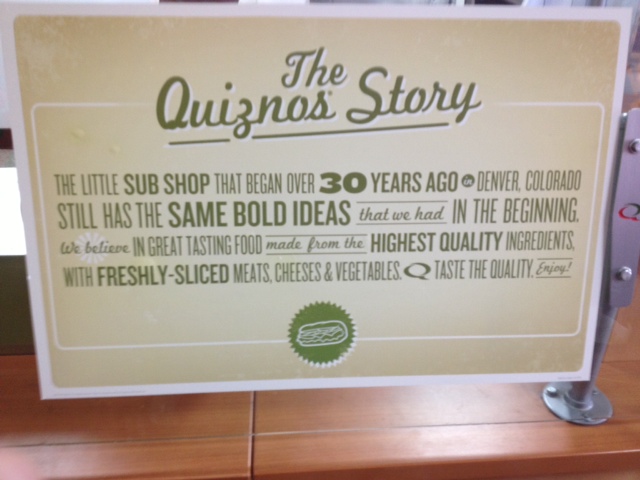How You Tell a Brand Story Matters
Sometimes it’s easier to learn positioning and branding lessons when we look outside our field.
Let’s look at a lesson from the world of fast food. Then we’ll see how it applies to our brands as consultants and thought leaders.
A few days ago, I was eating at my local Quiznos sub shop, and a sign inside the store caught my attention.
The sign is hard to miss. It’s affixed to a barrier separating the food-preparing staff from customers. To place an order, customers more or less have to peer over the sign. Given such prominent placement, it must say something important, right?
Its headline: “The Quiznos Story.”
Now, that headline might not mean much to you, but I’ve got to admit — as a positioning and branding geek — when I first read it my curiosity was piqued. In my world, the word “story” carries weight.
Sometimes story refers to a business’s brand story, and how the business delivers value through a big differentiating idea or striking promise.
Other times story refers to a business’s backstory, which tells us why the business began in the first place, and how what it does is important in ways that go beyond merely making money.
Whatever kind of story being used, when you see the word in a marketing context, you know you’re likely going to find out about the brand’s core idea or competitive advantage.
What’s more, the brand will probably tell its story entertainingly, so you’ll share it with others.
I continued reading.
The sign’s first line taught me three facts about Quiznos: 1. It began, not as a franchise, but as a single store. 2. It started thirty years ago 3. It originated in Denver.
So far, so good. I could picture the company’s birth, because the scene was established with facts. Facts are concrete and fashion explicit images in the mind.
I was ready for the payoff: How is Quiznos different? What intriguing point would I share with my wife and friends? (“Stella, I was in Quiznos today. You want to hear something cool?”)
Here’s where the story sputtered.
The sign’s second line mentioned “BOLD IDEAS,” which threw me. I enjoy Quiznos’ food and atmosphere, but I never think about the experience as bold.
The third and fourth lines explained what Quiznos considered bold: “Great Tasting Food,” “HIGHEST QUALITY INGREDIENTS,” and “FRESHLY-SLICED MEATS, CHEESES & VEGETABLES.”
I felt duped.
Here I was excited to learn what separated a brand I enjoy from the rest of the pack, and what I was fed was a surface story that – excluding the part about thirty years ago in Denver – could have been trumpeted by any competitor.
For a sub shop to say it believes in great-tasting food, consisting of freshly-sliced quality ingredients, is like a automobile manufacturer saying it believes in building cars that drive forwards and backwards. Or, a computer maker bragging about how its machines can connect to the internet.
The story Quiznos told may be true, but it wasn’t told in a way that would make a dent in anyone’s consciousness. I’m guessing few customers have read that sign fully or remember what it said if they did.
What can we as consultants and thought leaders learn here?
How we tell a marketing story matters. If we tell people only what they know and expect, they’ll ignore us.
What our brand story or backstory needs is . . . a context . . . an insight . . . a promise . . . a substantiation . . . a frank detail . . . an unexpected bit of color . . . that forces our audience to look anew at what they thought they already knew.
For example, if you’re a consultant whose main message is about helping organizations “change” and “accelerate results,” you’re not giving your audience any reason to consider you over a competitor, because you sound like hundreds of thousands of other consultants.
Your language is too general. There’s nothing for us to picture. Your message needs a meaningful difference and specifics.
You need to tell us things you know, but we don’t. Doing so will make us sit up and take notice. We may also be intrigued enough to call you so we can find out more.
If you’d like to try your hand at creating a brand story that people will remember, consider the following three questions:
1. What do you know that (most of) your market doesn’t know about your subject?
2. What do you know that (most of) your market doesn’t know about your company?
3. In answering the first two questions, what ideas and stories did you discover that your market would find equally surprising and valuable?
Your answers can serve as the basis for a draft of a brand story that is fresh, exciting, and uniquely yours.
